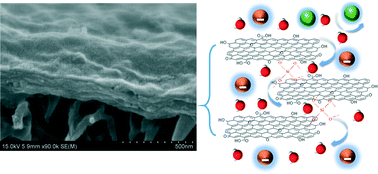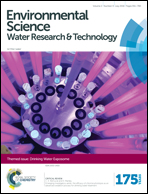Emerging investigators series: silica-crosslinked graphene oxide membrane and its unique capability in removing neutral organic molecules from water
Abstract
This study reports the synthesis and physicochemical properties of a silica-crosslinked graphene oxide (GO) membrane, and highlights its unique capability to remove neutral organic molecules from water. The silica-crosslinked GO membrane was formed by soaking a layer-stacked GO film in saturated silica solution and remained stable under various test conditions. Comparison of the chemical compositions of the GO membrane before and after silica crosslinking indicates that silica mainly reacted with the carboxyl groups in GO. The GO membrane was negatively charged and found to remove the tested neutral organic molecules (glucose and sucrose) (∼84% to 90%) much more efficiently than the tested negatively charged ionic species (trisodium citrate/TSC) (∼22%). This unique separation behavior is quite interesting, as it is generally known that a charged nanofiltration or reverse osmosis membrane would remove charged species much better than neutral molecules of comparable sizes. Our experimental evidence suggests that neither size exclusion nor ionic strength is responsible for such unique behavior. Characterization of the interactions between the GO membrane and the tested neutral organic species indicates that the low partitioning and irreversible adsorption of neutral organic molecules into the GO membrane (much less than that of charged ionic species) is most likely responsible for their better removal by the GO membrane.

- This article is part of the themed collection: Emerging Investigator Series

 Please wait while we load your content...
Please wait while we load your content...